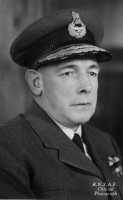Leonard Monk Isitt
| Sir Leonard Monk Isitt | |
|---|---|

AVM Sir Leonard Monk Isitt
|
|
| Born |
27 July 1891 Christchurch, New Zealand |
| Died | 21 January 1976 (aged 84) Lower Hutt, New Zealand |
| Allegiance | New Zealand |
| Service/branch |
New Zealand Army Royal New Zealand Air Force |
| Rank | Air Vice Marshal |
| Commands held | Chief of the Air Staff |
| Battles/wars |
World War I World War II |
| Awards | Knight Commander of the Order of the British Empire |
| Other work | Chairman of Tasman Empire Airways |
| Signature | |
Air Vice Marshal Sir Leonard Monk Isitt KBE (27 July 1891 – 21 January 1976) was a New Zealand military aviator and senior air force commander. In 1943 he became the first New Zealander to serve as the Chief of the Air Staff of the Royal New Zealand Air Force, a post he held until 1946. At the close of World War II, Isitt was the New Zealand signatory to the Japanese Instrument of Surrender. After the war he worked as chairman of Tasman Empire Airways.
Leonard Monk Isitt was born on 27 July 1891 in Christchurch, New Zealand, the son of the Methodist minister, member of parliament and prohibitionist Leonard Monk Isitt and Agnes Martha Caverhill. Leonard Monk Isitt junior was educated at Mostyn House, Cheshire, England and Christchurch Boys' High School. He had one brother, Willard Whitmore Isitt (1894–1916) who was a Rifleman in the New Zealand Rifle Brigade in World War I and was killed in France on 31 October 1916.
In World War I he served in the New Zealand Army in the New Zealand Rifle Brigade. On 10 May 1917 he was granted a probationary commission in the Royal Flying Corps as a second lieutenant, which was confirmed a month later. In 1918 he was transferred to the Royal Air Force. During his time with the British air services Isitt served as a pilot and flew bombers over French battlefields.
At the close of World War I, New Zealand had no military air organisation of any sort. On the request of the New Zealand government, the British Air Ministry sent Colonel (later Group Captain) A V Bettington to New Zealand to advise on the establishment of an air service. Bettington brought four aircraft with him and they were based at Sockburn airfield (later to become RNZAF Station Wigram). It was to this embroyonic state of affairs that Isitt was to return. In 1919 Isitt, then a captain, was posted back to New Zealand where he was sent to Sockburn airfield to take care of the four aircraft and serve as commanding officer. Additionally Isitt served as the liaison officer to the Canterbury Aviation Company on behalf of the government.
...
Wikipedia
